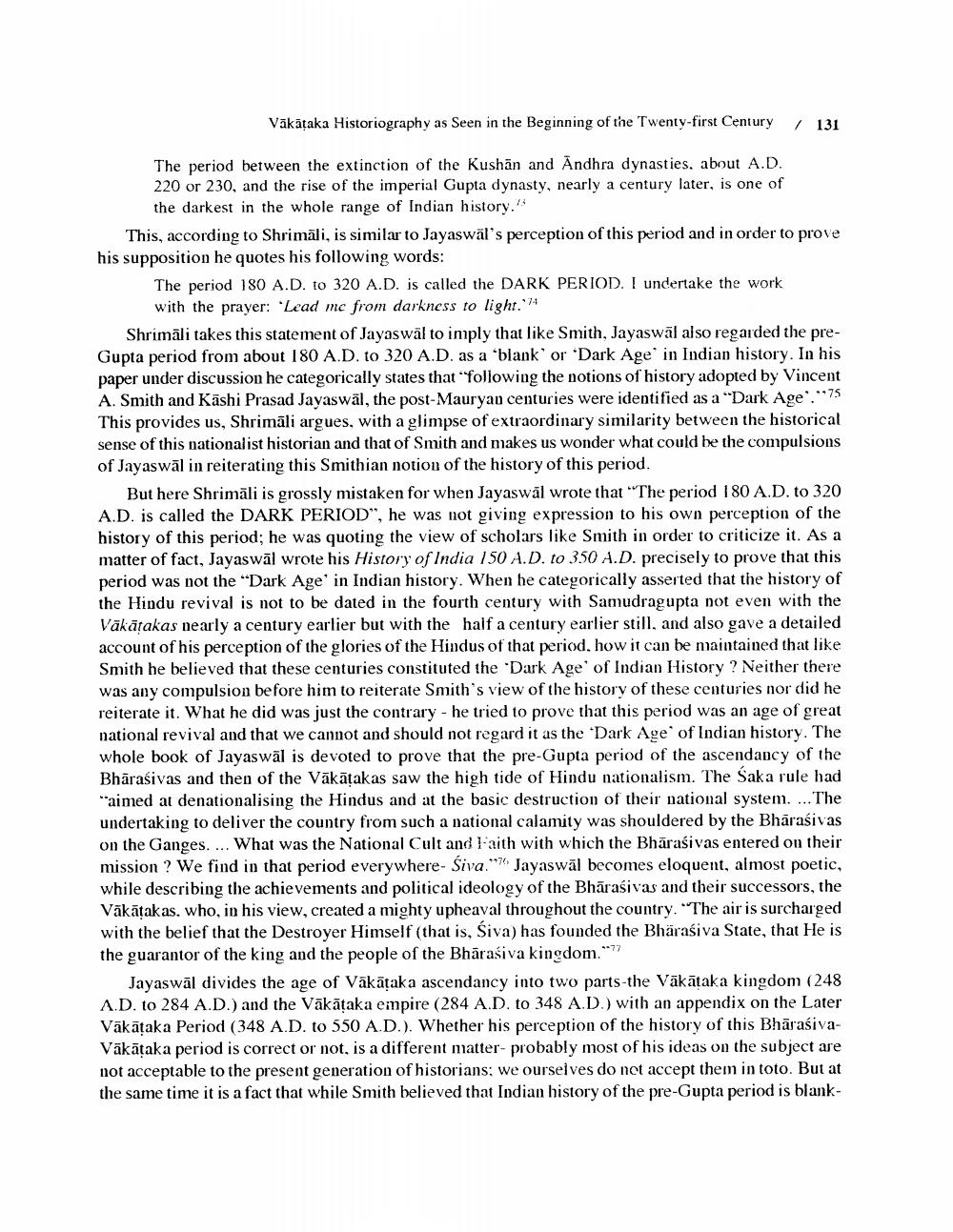________________
Vākāṭaka Historiography as Seen in the Beginning of the Twenty-first Century
The period between the extinction of the Kushan and Andhra dynasties, about A.D. 220 or 230, and the rise of the imperial Gupta dynasty, nearly a century later, is one of the darkest in the whole range of Indian history.
/ 131
This, according to Shrimali, is similar to Jayaswal's perception of this period and in order to prove his supposition he quotes his following words:
The period 180 A.D. to 320 A.D. is called the DARK PERIOD. I undertake the work with the prayer: Lead me from darkness to light."74
Shrimali takes this statement of Jayaswal to imply that like Smith, Jayaswal also regarded the preGupta period from about 180 A.D. to 320 A.D. as a 'blank' or 'Dark Age' in Indian history. In his paper under discussion he categorically states that "following the notions of history adopted by Vincent A. Smith and Kashi Prasad Jayaswal, the post-Mauryan centuries were identified as a "Dark Age"."75 This provides us, Shrimali argues, with a glimpse of extraordinary similarity between the historical sense of this nationalist historian and that of Smith and makes us wonder what could be the compulsions of Jayaswal in reiterating this Smithian notion of the history of this period.
But here Shrimali is grossly mistaken for when Jayaswal wrote that "The period 180 A.D. to 320 A.D. is called the DARK PERIOD", he was not giving expression to his own perception of the history of this period; he was quoting the view of scholars like Smith in order to criticize it. As a matter of fact, Jayaswal wrote his History of India 150 A.D. to 350 A.D. precisely to prove that this period was not the "Dark Age' in Indian history. When he categorically asserted that the history of the Hindu revival is not to be dated in the fourth century with Samudragupta not even with the Vākāṭakas nearly a century earlier but with the half a century earlier still, and also gave a detailed account of his perception of the glories of the Hindus of that period, how it can be maintained that like Smith he believed that these centuries constituted the 'Dark Age' of Indian History? Neither there was any compulsion before him to reiterate Smith's view of the history of these centuries nor did he reiterate it. What he did was just the contrary - he tried to prove that this period was an age of great national revival and that we cannot and should not regard it as the 'Dark Age' of Indian history. The whole book of Jayaswal is devoted to prove that the pre-Gupta period of the ascendancy of the Bhārasivas and then of the Vakatakas saw the high tide of Hindu nationalism. The Saka rule had "aimed at denationalising the Hindus and at the basic destruction of their national system. ...The undertaking to deliver the country from such a national calamity was shouldered by the Bhārasivas on the Ganges.... What was the National Cult and Faith with which the Bhārasivas entered on their mission? We find in that period everywhere- Śiva." Jayaswal becomes eloquent, almost poetic, while describing the achievements and political ideology of the Bhārasivas and their successors, the Vākāṭakas. who, in his view, created a mighty upheaval throughout the country. "The air is surcharged with the belief that the Destroyer Himself (that is, Śiva) has founded the Bharaśiva State, that He is the guarantor of the king and the people of the Bhārasiva kingdom."77
Jayaswal divides the age of Vākāṭaka ascendancy into two parts-the Vākāṭaka kingdom (248 A.D. to 284 A.D.) and the Vākāṭaka empire (284 A.D. to 348 A.D.) with an appendix on the Later Vākāṭaka Period (348 A.D. to 550 A.D.). Whether his perception of the history of this BhārasivaVākāṭaka period is correct or not, is a different matter- probably most of his ideas on the subject are not acceptable to the present generation of historians; we ourselves do not accept them in toto. But at the same time it is a fact that while Smith believed that Indian history of the pre-Gupta period is blank




